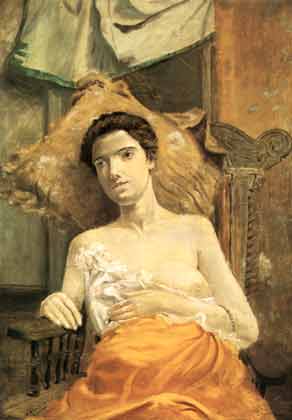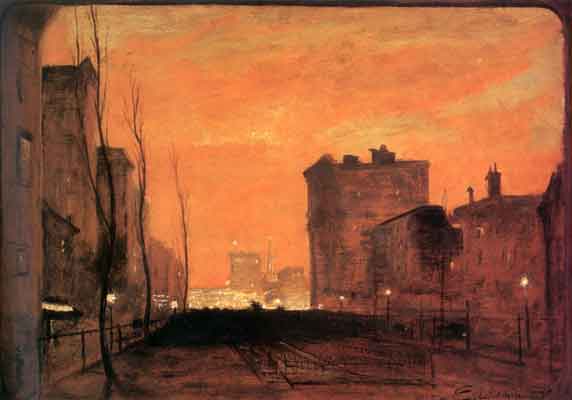Louis M. Eilshemius
(1864 - 1941) :
An Independent Spirit
by Donald Goddard

Mother Bereft
Louis M. Eilshemius(1864 - 1941) :An Independent Spiritby Donald Goddard |

Mother Bereft |
|
Of the artists I know about who were revered by other artists but not generally appreciated at the same time--including Thomas Eakins, Albert Pinkham Ryder, and Henri Rousseau -- Louis Eilshemius is still the most obscure. Despite his academic training in New York and Paris, prodigious self-promotion, and voluminous publication of musical compositions, verse, novels, short stories, and periodicals, he remained unappreciated, even shunned, by his own generation and his elders. He traveled widely on family money and thought of moving to California and Rome, but stayed in New York at the family brownstone on East 57th Street, finally in dire poverty, until his death. He was appreciated, however, by some artists in the generation following his, by Marcel Duchamp, who discovered him in 1917, and by Gaston Lachaise, David Burliuk, Joseph Stella, Abraham Walkowitz, and later Louis Nevelson and others. He stopped painting in 1921, perhaps confounded by the chronological disjunction regarding his reputation, though there is one painting in this exhibition from 1937--Zeppelin in Flames Over New Jersey. |
|
It's not that there are no precedents or contemporary
parallels in American art for Eilshemius's visionary kind of work, particularly
in regard to his inclusion of and obsession with the female nude. But his references
are not mythological, like those of Elihu Vedder and Arthur B. Davies, or societal,
like Thomas Dewing, or exotic, like John LaFarge. Figures appear as though emerging
from some inner realm or unpredictable phenomenon. There is no explanation, except,
perhaps, as Paul Karlstrom suggests in his moving catalogue essay, in Eilshemius's
own concurrent love of the world and romantic disappointment.
|
|
Even his early work, in which he is closer to his academic training, has a strange sense of displacement and transcendence. Mother Bereft of about 1890 was apparently painted after a model, and, while it conveys a certain mood of melancholy, its true subject, if any, is unknown, though its title may refer to the suffering of Eilshemius's own mother, who lost three of her six children in their youth. But it is this very indeterminacy and moodiness that seems to interest Eilshemius. The face and figure of the young woman are specific and specifically placed but also curiously made up, composed like a wood carving, or like the chair, which itself is exquisitely detailed. Everything is there in a masterful composition but obeying no sensible laws. The pillow perches precariously behind the woman's head. The curtain hangs oddly against a blank window-like shape. There is no indication of the continuation of the right elbow. The woman's expression is one of resigned dreaminess that both contrasts and complies with the agitation of her surroundings, the interplay of shapes and "symphony of lines," in the artist's words. Eilshemius talked in 1920 about having changed his style and escaped academicism just ten years before that, but in fact his aesthetic is already present here. "All the lines must convolute into each other," he said in 1920, "winde [sic] about each other, until every line goes to the center of the painting," which in the case of Mother Bereft is the woman's turning neck. As present as these motives are, they exist on canvas, the weave of which is laid bare in the depiction of the wall and even in the flesh, as it is also in the paintings of Edvard Munch and other artists of this period. This, in other words, is art in its most powerful emanation. |
 Mother Bereft, ca. 1890, Hirshhorn Museum and Sculpture Garden Smithsonian Institution. Gift of the Joseph H. Hirshhorn Foundation, 1966. |
|
Eilshemius is unwilling to see things as we imagine they are normally seen, either as "objective reality" or cast in a mythological, religious, or class narrative. The results, most extremely, are fantasies that have no name except the ones he gives them, such as The Demon of the Rocks of 1901. More frequently the scenes are places that are real in the world--in New York City, the Delaware River Water Gap, the Catskill Mountains, California, Samoa, Spain, North Africa--and they are understood to be real but also extensions of the artist's will (". . . if the Will was active, everything could be accomplished," he wrote in his 1907 collection of sonnets, Mystery and Truth). The bereft mother, in her sensuality and emotion, causes alarm in the painting itself, and in us. She changes the scene and fixes it indelibly in our minds. And this was just the beginning. In Afternoon Wind of 1899 the six female nudes are part of an otherwise familiar, endearing landscape. Finally, we don't question their floating presence because they are an expression of the emotion that the landscape itself induces and cannot be separated out once they have been introduced. The women are neither goddesses nor nymphs but rather, probably, studio models, and therefore art images of women as the painted landscape is the image of a place. They might be standing by the stream, and that would be no less fantastic, only more comfortable. Eilshemius manages to indicate and to make no mistake about where the locus of art is. |
 Autumn Evening, Park Avenue, New York, 1915 Oil on Board, 26 1/4" x 36". Roy R. Neuberger Collection |
|
It seems that most of Eilshemius's paintings after 1910, when he says he stopped painting in the academic style, are golden orange and brown, perhaps the world on fire or transfigured by light and fire, whereas before there had been modulated shades that included green and blue as well. Now this new light and the more loosely thrusting of brushstrokes and lines become the carriers of idealism and his own presence in his work. They create a pervasive ambience of extremity. The compositional structure of the painting, particularly in landscapes, becomes a stage on which a drama is played out in a conflagration of light in darkness, of palpable turmoil that is carried by the strokes themselves. Most of his paintings of New York, where he lived, are nocturnes, as they had always been. Buildings and street are the stage in Autumn Evening, Park Avenue, New York of 1915, an artificial foreground perspective, bordered at its far edge by a troubling blackness, that exists as a fragile silhouette in relation to the glow of the sky and the distant buildings. Everything is imbued with the heightened illumination of the distance, which ultimately emanates from the cardboard on which it is painted. It is the board, yet miles away. In his last painting, Zeppelin in Flames Over New Jersey of 1937, a depiction of the Hindenburg disaster, the light is a golden explosion that eliminates almost everything except the artifice. Donald Goddard © 2001 |
|
i Paul J. Karlstrom, "Eilshemius Redux," in Louis M. Eilshemius (1864-1941): An Independent Spirit, pp. 34-43. New York: National Academy of Design, 2001. ii Louis M. Eilshemius, "An Informal Talk, Given at the Museum of Modern Art, Societe Anonyme Inc, 19 E. 47t h Street, October 15, 1920." Ibid, p. 45. iii Quoted in Steven Harvey, "Against the Grain: The Paintings of Louis Michel Eilshemius." Ibid., p. 10. |
Art Review - NYArtWorld.com - NYAW.com. All artwork is copyright of the respective owner or artist. All other material © Copyright 2015 New York Art World ®. All Rights Reserved.
New York Art World ® - Back to Top